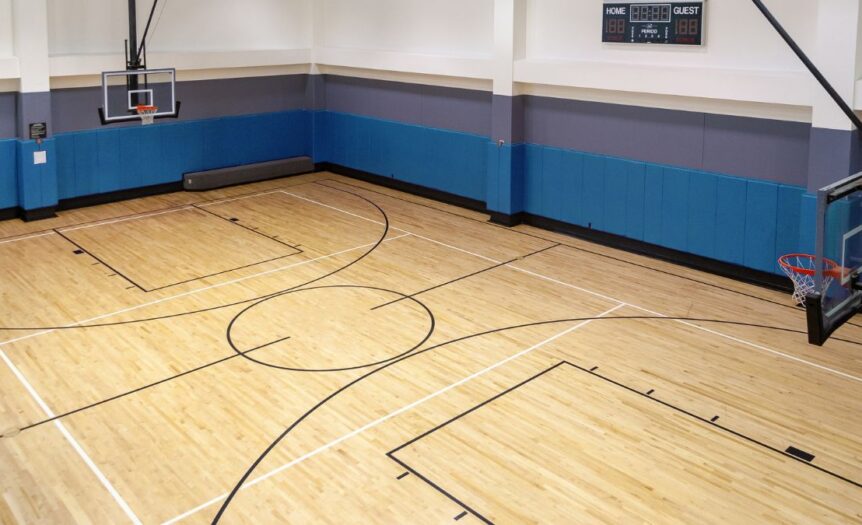School gymnasiums have been around for many years, but designing one today requires assessing the modern technology and techniques that school staff members can use. A gymnasium is an important space in any school, as it serves as a multi-purpose area for physical education classes, sports practices and games, and other events, such as assemblies and performances.
A well-designed gymnasium enhances the learning experience and promotes health and wellness among students. Create a productive space using these tips for designing a great school gymnasium.
Assess the Space and Functionality
One of the first steps to take when creating a modern school gym is finding a function for each space. For instance, maybe the school can use the entire room as an open gym/basketball court layout where gym classes can happen during the day and matches happen at night.
That said, would it be more efficient for the school’s specific needs to dedicate a certain amount of space to workout equipment? On the other hand, maybe having the fitness equipment in another specifically designed room makes more sense. Every school is unique. When designing a gym, know how the school will use every inch of that space. This will help in determining the size, layout, and equipment needed for the gymnasium.
Optimize the Flooring
The type of flooring used in a gymnasium is crucial as it can impact the safety and performance of those using the space. A gym is an active space, whether the school is using it for sports or general gym class activities. Unfortunately, heavy foot traffic will quickly damage certain flooring.
Thankfully, schools can find options, such as rubber flooring materials, that prevent slipping and will withstand the impact of frequent foot traffic. Foam flooring materials also present an alternative that’s easy to install and will accommodate physical activities comfortably. Choose high-quality, durable materials for a school’s gym to ensure it looks beautiful and will retain that beauty for a long time.
Fine-Tune the Acoustics
With various activities taking place in a gymnasium, it’s important to consider acoustics to prevent noise disturbance and enhance the overall experience. Much like with the flooring, choosing the right materials to put on a gym’s walls and ceiling will help schools control sound quality.
For example, schools building or upgrading gymnasiums can browse acoustic panels for commercial spaces, such as gymnasiums, to combat excessive echoing. Acoustic panels are sound-absorbing materials that can reduce echoes and improve sound quality. That way, if one gym class is using the basketball court and another is using the gym equipment at the other end of the room, they can both enjoy a less distracting environment.
Use each of these tips today to create the perfect environment for students and faculty to work in. A well-designed school gymnasium can greatly benefit students by promoting physical activity, teamwork, and overall well-being. By following these tips to design a great school gymnasium, anyone can create a space that meets the needs of their school and enhances the educational growth of students.










 Deering Estate
Deering Estate
 Massage Envy South Miami
Massage Envy South Miami
 Calla Blow Dry
Calla Blow Dry
 My Derma Clinic
My Derma Clinic
 Sushi Maki
Sushi Maki
 Sports Grill
Sports Grill
 The Healthy Kitchen
The Healthy Kitchen
 Golden Rule Seafood
Golden Rule Seafood
 Malanga Cuban Café
Malanga Cuban Café

 Kathleen Ballard
Kathleen Ballard
 Panter, Panter & Sampedro
Panter, Panter & Sampedro
 Vintage Liquors
Vintage Liquors
 The Dog from Ipanema
The Dog from Ipanema
 Rubinstein Family Chiropractic
Rubinstein Family Chiropractic
 Your Pet’s Best
Your Pet’s Best
 Indigo Republic
Indigo Republic




 ATR Luxury Homes
ATR Luxury Homes


 2112 Design Studio
2112 Design Studio
 Hamilton Fox & Company
Hamilton Fox & Company
 Creative Design Services
Creative Design Services
 Best Pest Professionals
Best Pest Professionals
 HD Tree Services
HD Tree Services
 Trinity Air Conditioning Company
Trinity Air Conditioning Company
 Cisca Construction & Development
Cisca Construction & Development
 Mosquito Joe
Mosquito Joe
 Cutler Bay Solar Solutions
Cutler Bay Solar Solutions


 Miami Royal Ballet & Dance
Miami Royal Ballet & Dance
 Christopher Columbus
Christopher Columbus
 Pineview Preschools
Pineview Preschools
 Westminster
Westminster
 Carrollton
Carrollton
 Lil’ Jungle
Lil’ Jungle
 Frost Science Museum
Frost Science Museum
 Palmer Trinity School
Palmer Trinity School
 South Florida Music
South Florida Music
 Pinecrest Orthodontics
Pinecrest Orthodontics
 Dr. Bob Pediatric Dentist
Dr. Bob Pediatric Dentist
 d.pediatrics
d.pediatrics
 South Miami Women’s Health
South Miami Women’s Health

 The Spot Barbershop
The Spot Barbershop
 My Derma Clinic
My Derma Clinic




 Miami Dance Project
Miami Dance Project

 Rubinstein Family Chiropractic
Rubinstein Family Chiropractic
 Indigo Republic
Indigo Republic

 Safes Universe
Safes Universe
 Vintage Liquors
Vintage Liquors
 Evenings Delight
Evenings Delight





 Atchana’s Homegrown Thai
Atchana’s Homegrown Thai
 Baptist Health South Florida
Baptist Health South Florida

 Laser Eye Center of Miami
Laser Eye Center of Miami
 Visiting Angels
Visiting Angels
 OpusCare of South Florida
OpusCare of South Florida

 Your Pet’s Best
Your Pet’s Best





 HD Tree Services
HD Tree Services
 Hamilton Fox & Company
Hamilton Fox & Company


 Creative Design Services
Creative Design Services